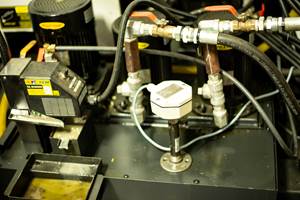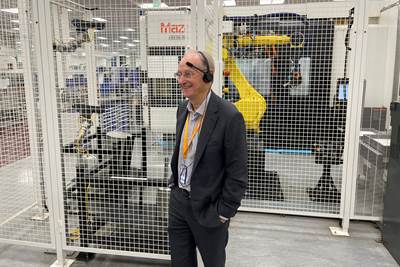Increasing OEM Visibility to Shopfloor Operations for the Win
A former employee of General Motors and Tesla talks about the issues that led to shutdowns on factory lines, and what small- to medium-sized manufacturers can do today to win business from large OEMs.
Share




It is now well understood that increased productivity is the only way that American manufacturers can compete with lower-wage countries. But the costs involved with increasing productivity are not distributed evenly throughout our manufacturing base. Today, there is often a steep disparity between the manufacturing output per employee at large American manufacturing companies compared to small- to mid-sized manufacturers.
Ryan Kuhlenbeck spent nearly two decades at General Motors, Tesla and Alta Motors before co-founding Pico MES, a manufacturing execution system designed to specifically address the kinds of frustrations between supplier and manufacturer that Kuhlenbeck experienced in the automotive industry. I sat down with him to discuss the nature of those frustrations and ways to even the playing field between small and large manufacturers.
Modern Machine Shop (MMS): Talk about the automation disparities that you’re seeing between small and large manufacturing companies. What are the dangers associated with these disparities?
I find it interesting how different technology rolls out and across different adoption paths. I think there’s a very big difference in the adoption curves and those differences correlate directly to factory size.
No matter what you’re trying to achieve, at least in automotive and aerospace, you’re limited by the supply base. The technology that tier 3s and tier 4s can bring to bear is completely different than what large manufacturers have inside of their factories.
If we continue to sit back and wait for business cases to drive things, or wait for the new generation to take over, I think that’s too slow and that we’re missing opportunities now. This is based on my experience understanding what shuts down large factories. I can give you a hint, it’s not their equipment.
MMS: Talk a bit more about that — about the kinds of issues that shut down the production lines at large manufacturing facilities.
Expecting people to be perfect all day is like doing a 1,000-piece jigsaw puzzle and expecting to find all the edge pieces on the first sort. Good luck, but I wouldn’t want to do it day in and day out.
If instead you have connected tools that give them error proofing, where they’re making sure that they shot all the bolts or they scanned a barcode, or they torqued all the fasteners to hold the part down so the spindle doesn’t crash into it, all of these kinds of things are like little spot solutions that underpin factories and allow them to make their products better, faster, cheaper.
If you can see that these 20 parts were built and then went into the CMM, you know your max exposure because it first appears during that inspection. And more importantly, you know exactly which 20 parts risk having the issue and where they are. And instead of the shopfloor workers having to be perfect, you can now guide them through the rest of the process and back them up with error proofing.
MMS: A lot of what you’re discussing relates to assembly operations in factories. Can you talk more specifically about how this discussion applies to machine shops?
In a job shop and machine shop world, the parts they’re making are often going somewhere else to get assembled into something. If they’re building 30 of something, and there’s variation across those 30 parts, how can I take that data when it’s going upstream and manage problems? How can a get to a point where I can say, here’s when this part was made using this program inside of this side of the CNC machine?
If a part consistently has fit issues in the fixtures or whatever the case might be, if your systems are connected across the supply chain, you know who the tier 3 or tier 4 supplier is and if one part has the issue or 500 of them. Most OEMs are blind to that.
Another example: I remember a time in my former career when we were machining 6005 (aluminum alloy), and I knew the exact grade because I received mass spectrometer readings on some of them. Yet those chips went into a bucket, and because it was a midsize factory that didn’t have the capability to track it, the chips went through generic recycling scrap.
They only received 50 cents a pound instead of 80 cents a pound that the alloy was worth. These seemingly small discrepancies add up to a lot over time.
MMS: Essentially you’re talking about creating networked visibility across supply chains that ultimately make shops more attractive to OEMs.
For the forward-looking shops, it’s about making sure you’re prepared for more stringent requirements that will be heading our way in the near future. If you’re a job shop, it’s not a bad idea to be asking yourself, what are the solutions that are appropriate for a size of shop and the type of work that I do?
OEMs always have a connection to their tier 1s, but what about the other direction? As a job shop, who’s your supplier? And what data would you find valuable from them? You know, it can start as simple as a label on the parts when they’re delivered to you that you bring into your system. How do you win OEM business? You need to show them that you’re cost competitive and that you have high quality standards, especially in auto and aerospace.
You can’t do that if you’re pulling up Excel sheets and trying to talk about measurements hand made with a caliper. If you’re trying to grow and you’re trying to win more of this business, you need a backbone that gives you the ability to say, “Here’s the measurement. Here’s the last time it ran across CMM. We run every 20. Here’s the audits we do in-place. Here’s an image that guy took with a tablet of checking the part.”
If you offer that up, can you charge an extra quarter per part for high volume or an extra dollar for low volume? Ultimately, how do you get 10% more profitability for your shop? The answer is almost always little 1% fixes here and there.
Related Content
3 Ways Artificial Intelligence Will Revolutionize Machine Shops
AI will become a tool to increase productivity in the same way that robotics has.
Read MoreManaging Coolant with Skimmers, Refractometers and More
Bacteria-infected coolant harms machines and sickens machinists. Coolant management technologies like skimmers and automated systems counter this tendency.
Read MoreFour-Axis Horizontal Machining Doubles Shop’s Productivity
Horizontal four-axis machining enabled McKenzie CNC to cut operations and cycle times for its high-mix, high-repeat work — more than doubling its throughput.
Read MoreCNC Machine Shop Honored for Automation, Machine Monitoring
From cobots to machine monitoring, this Top Shop honoree shows that machining technology is about more than the machine tool.
Read MoreRead Next
The Link Between CNC Process Control and Powertrain Warranties
Ever since inventing the touch-trigger probe in 1972, Sir David McMurtry and his company Renishaw have been focused on achieving process control over its own manufacturing operations. That journey has had sweeping consequences for manufacturing at large.
Read MoreSetting Up the Building Blocks for a Digital Factory
Woodward Inc. spent over a year developing an API to connect machines to its digital factory. Caron Engineering’s MiConnect has cut most of this process while also granting the shop greater access to machine information.
Read MoreRegistration Now Open for the Precision Machining Technology Show (PMTS) 2025
The precision machining industry’s premier event returns to Cleveland, OH, April 1-3.
Read More





















.jpg;maxWidth=300;quality=90)









.jpg;maxWidth=970;quality=90)